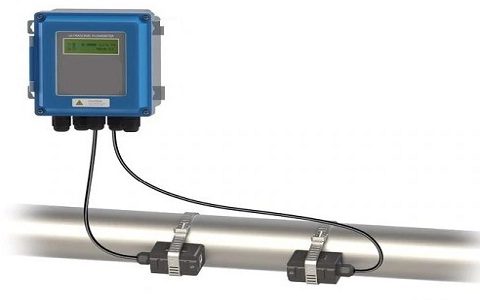Table of Contents
An ultrasonic flow meter can be defined as a meter, which is used to measure liquid velocity with ultrasound in order to analyze the volume of liquid flow. This is a volumetric flow meter that requires bubbles or minute particles within a liquid flow. These meters are suitable for waste water use but will not work with drinking/distillation water. So this type of flow meter is ideal for applications where chemical compatibility, low maintenance and low pressure drop are required. These meters will affect the audio properties of the liquid and also influence via viscosity, density, temperature, etc. Like mechanical flow meters, these meters do not include moving parts. These meters will vary greatly in price so they can be used and maintained at a low cost.
Ultrasonic Flow Meter Working Principle
An ultrasonic flow meter can be manufactured using upstream and downstream transducers, sensor pipes and reflectors. The working principle of an ultrasonic flow meter is, it uses sound waves to measure the velocity of a liquid within a pipe. There are two conditions in a pipe namely no flow and flowing. In the first case, the frequencies of ultrasonic waves are transmitted in a pipe and its signals from the fluid are identical. In the second case, the frequency of the reflected wave varies due to the Doppler effect. Whenever liquid flows rapidly in the pipe, the frequency shift can be increased linearly. The transmitter processes the signals from the wave and its reflections determine the flow rate. Transit time meters transmit and receive ultrasonic waves in both directions within the pipe. In the case of no-flow, the time taken for current to flow between the transducer upstream and downstream is the same. Under these two flowing conditions, the wave on the upstream will flow at a lower speed than the wave downstream. As the liquid flows faster, the time difference between the top and bottom increases. The timing of the upstream and downstream processed by the transmitter to determine the flow rate.
Ultrasonic Flowmeter Type
There are two types of ultrasonic flow meters currently in use. They Time difference type and Doppler flow meter.
Time difference Ultrasonic Type
This devices measure flow by measuring the time taken ultrasonic wave to transverse a pipe section, both wit and against the flow of liquid within the pipe. It consist of two transducers, A & B, inserted into a Pipe line, and working both as transmitter and receiver. The ultrasonic waves are transmitted from transducer A and transducer B and vice versa. An electronic oscillator is connected to supply ultrasonic waves alternately to A or B which is working as transmitter through a change over switch, when the detector is connected simultaneously to B OR A which is working as receiver. The detector measures the transit time from upstream to downstream transducers and vice versa.





The time T A B for ultrasonic wave to travel from transducer A to transducer B is given by the expression:
TA B = L / (C + V COS h)
And the time (T B A ) to travel from B to A is given as,
TBA = L / (C – V COS )
Where,
L = acoustic path length between A & B C = Velocity of sound in the fluid
h = angle of path with respect to the pipe axis V = velocity of fluid in pipe
The time difference between T A B and T B A an be calculated as,
< h T = TA B – TBA = ( 2 L V COS h ) / C
Or V = < T C / ( 2 L COS h )
Since, this type of flowmeter relies upon an ultrasonic signal traversing across the pipe; the liquid must be relatively free of solid and air bobbles.
Doppler Ultrasonic Flowmeter
In Doppler flow meters, an ultrasonic wave is projected at an angle though the pipe wall into the liquid by a transmitting crystal in a transducer mounted outside the pipe. Part of the ultrasonic wave is reflected by bubbles or particles in the liquid and is returned through the pipe wall to the receiving crystal. Since the reflector (bubbles ) are travelling at the fluid velocity, the frequency of the reflecting wave is shifted according to the Doppler principle. The velocity of the fluid is given by the equation:
V = (∆ f Ct )/ (2 fo COS ) = ∆ f k
Where
∆ f = difference between transmitted and received frequency
C t = velocity of the sound in the transducer
F o = frequency of the transmission
θ = angle of transmitter and receiver crystal with respect to the pipe axis.
K = constant
Advantage Ultrasonic Flowmeter
- Dose not impose additional resistance to the flow or disturb the flow patternas the transducers are inserted in the wall of pipe.
- Velocity / output relationship is linear
- No moving parts
- Repeatability is in the order of 0.01%
Read Also
